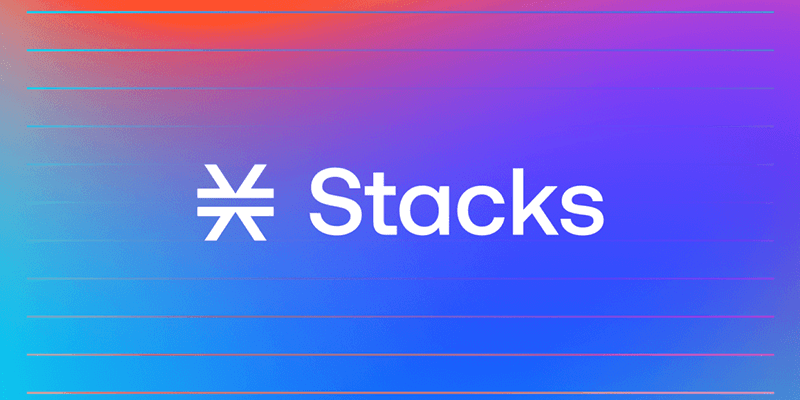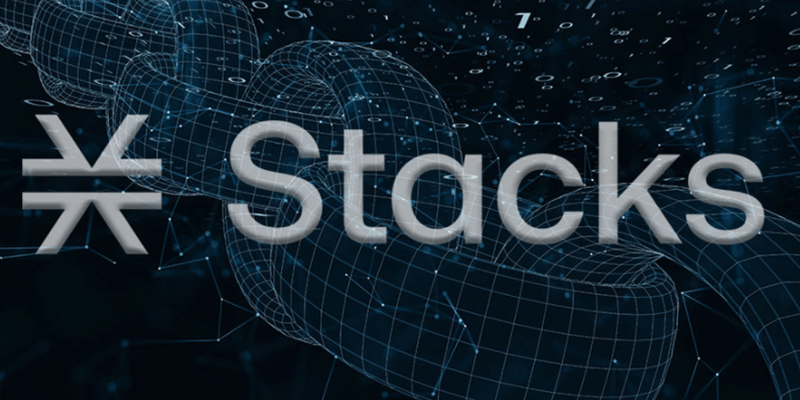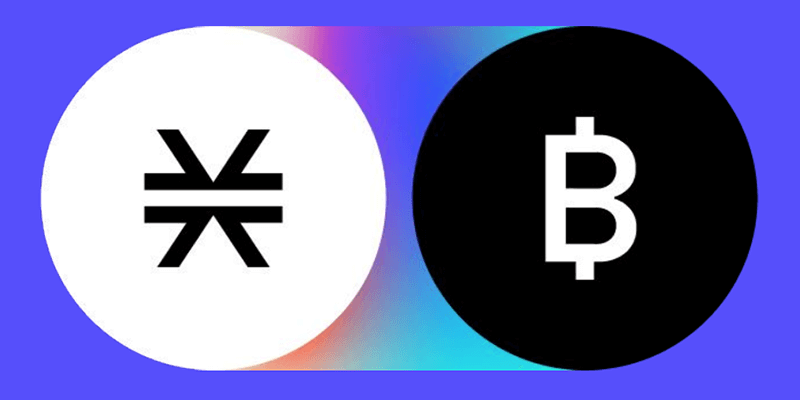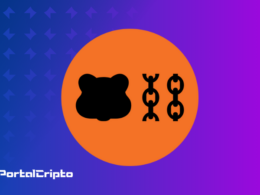The crypto Stacks project is a solution that is designed to bring smart contracts and decentralized applications (DApps) to Bitcoin (BTC). These smart contracts are carried over to Bitcoin without changing any of the features that make them powerful – including their security and stability.
In this article, we will discuss:
What is Stacks (STX)?
Stacks is a cryptocurrency platform built on a layer 1 blockchain that allows seamless transfer of DeFi applications and smart contracts to the Bitcoin network. When these platforms are added to the bitcoin network, they retain all of their usual features, including protocol security and stability.
Decentralized applications on the platform are designed to be modular and open. This implies that developers are allowed to build on top of each other's apps, allowing them to add extra layers of functions that would normally be impossible to add to regular apps. The building block of the Stacks platform is Bitcoin, a widely adopted and arguably the best and most secure network blockchain that exists.
The Stacks network is powered by a native token, STX. The token facilitates the execution of smart contracts on other related services on the network.
Before a rebranding in 2020, the Stacks platform was known as Blockstack. The rebranding was to separate the platform and other open source projects from Blockstacks PBC.
In January 2021, the platform minnet for Stacks 2.0 was launched.
Who are the founders of Stacks (STX)?
Initially, the Stacks network was funded by a collection of large venture capital funds, some of which include Digital Currency Group, Winklevoss and Y Combinator. The system was developed by a company located in New York known as Blockstack PBC.
However, the company changed its name from Blockstack PBC to Hiro System PBC as it joined a group of companies that are using the Stacks platform to build applications.
Blockstacks PBC was co-founded by Ryan Shea and Muneeb Ali. Muneeb Ali holds a Masters and Ph.D. from Princeton University and founded the Stacks platform with Shea in 2013. Ali currently serves as CEO of Hiro Systems PBC.
In the period that Ali served as CEO of the company, co-founder, Shea also served as co-CEO from 2013 until 2018, when he decided to leave the project to focus on other points of interest. Prior to her service at Stacks, Shea gained extensive experience in software engineering and worked for several corporations. He is currently involved with other cryptocurrency projects, one of which he is co-founder of a tech startup that currently operates under wraps.
How Does Project Stacks Work?
The Stacks network has the role of bringing applications created on other systems, including applications with ERC-20 specifications, to the Bitcoin network. While it can be used by everyday people, for platform developers, it presents more opportunities such as re-engineering existing applications to make them better. This development allows them to do things that would normally be impossible for a single decentralized application.
The network also has a native cryptocurrency token known as STX. The token for processing and executing transactions on the network, before registering digital assets on the Stacks 2.0 platform. All of these functions provide a level of value for the cryptocurrency, which in turn allows its holder to be able to exchange it for other cryptocurrency pairs such as USDT and WBTC.
Proof of Transfer: How Stacks Connects to Bitcoin
Proof of Transfer is the consensus mechanism that allows Stacks to connect with Bitcoin and expand its functionality without modifying the original cryptocurrency. In this article, we'll take a closer look at this process.
Consensus algorithms for blockchains require computational or financial resources to secure the network. The general practice of decentralized consensus is to make it virtually impractical for any malicious actor to have enough computing power or equity to attack the network.
There are several popular consensus mechanisms in modern blockchains, such as proof of work and proof of stake. Proof-of-burn is another less frequently used mechanism where miners compete by “burning” a proof-of-work cryptocurrency as a proxy for computing resources.
In the case of Stacks, Proof of Transfer (PoX) is used to secure the network. PoX uses the proof-of-work cryptocurrency of an established blockchain like Bitcoin to secure a new blockchain. However, instead of burning the cryptocurrency, miners transfer the compromised cryptocurrency to some other network participants.
This ensures that Stacks shares Bitcoin's unparalleled security for transaction reorganizations. The Stacks chain is linked to Bitcoin through its proof of transfer consensus mechanism, so all Stacks transactions are settled in Bitcoin.
In short, Proof of Transfer is the consensus mechanism that allows Stacks to connect to Bitcoin and extend its functionality without modifying the original cryptocurrency. This ensures that Bitcoin's unparalleled security is shared across Stacks, protecting the network from potential malicious attacks.
Bitcoin DeFi Stacks
Bitcoin’s DeFi market is uncharted territory, despite its market cap being close to $1 trillion and growing institutional adoption. However, unlike other cryptocurrencies, Bitcoin has not been as productive an asset for DeFi without the need to go through centralized exchanges or separate blockchains.
But Stacks is changing that scenario. The platform is uniquely positioned to enable true Bitcoin DeFi. This is because Stacks contracts are visible in the state of Bitcoin, and the platform has the inherent ability to leverage Bitcoin's security and settlement guarantees.
The Stacks chain is linked directly to Bitcoin through its proof-of-transfer consensus mechanism, ensuring that all Stacks transactions are settled in Bitcoin. This means that Stacks shares Bitcoin's unrivaled long-term security, which is crucial for protecting transactions from reshuffles.
With the help of Stacks, we can finally have true Bitcoin DeFi, allowing Bitcoin to be used as a productive currency in a variety of decentralized financial applications. The future looks bright for Bitcoin DeFi and Stacks is the solution everyone has been waiting for.
What is the difference of Stacks (STX)?
The Stacks network aims to take one of the greatest qualities of the Bitcoin network and include an extension of functionality. Depending on the platform, it provides this service without the need to fork or change the original Blockchain.
The platform is able to perform this function by connecting to the Bitcoin Blockchain directly through its proof-of-transfer consensus algorithm, which requires miners to make Bitcoin payments in order for new stack tokens to be minted. Stack network participants can also stack their STX tokens to earn rewards in the form of Bitcoin.
The Stacks network also unveiled a platform known as Clarity, which is a new type of intelligent contract programming operating with an unambiguous syntax that allows for ease of construction and platform security. The same programming language is also used by other blockchains, including the Aglorand blockchain.
In addition to the series of functions that differentiate the Stacks system from its contemporaries, the network was also the first qualified SEC cryptocurrency in the United States. This qualification allowed the platform to launch a Reg A+ cash sell offering worth $28 million for the platform's native token, STX.
Clarity programming language
As stated earlier, Stacks Blockchain provides support for smart contracts and decentralized applications. It also enhances the creation of flexible virtual assets that are easily transferable.
In an attempt to provide support for these smart contracts, the network uses the Clarity programming language to protect these activities.
The Clarity programming language is a predictable programming language that uses no compiler. Stacks deployed this programming language to help bring smart contracts to Bitcoin.
More precisely, the programming language uses predictable source code to execute smart contracts by publishing them to blockchain nodes.
The system therefore uses this tool to facilitate the security of the Stack ecosystem through decidable programming language.
Stacks and Bitcoin
Stacks and Bitcoin are basically two interconnected blockchain networks that work together. Interestingly enough, both blockchain networks don't depend on each other. They are independent networks connected through the Proof of Transfer consensus mechanism.
Through this system, miners can transfer new cryptocurrencies as well as smart Bitcoin contracts to other participants in the Stack network.
Bitcoin NFTs in Stacks
Although Bitcoin is the main cryptocurrency, the network does not support smart contracts. As a result, it cannot natively host NFTs, DeFi or dApps. However, Stacks, which supports smart contracts and executes Bitcoin transactions, makes it possible for the Bitcoin network to host NFTs and other decentralized applications.
Essentially, Stacks uses the Bitcoin network as the ultimate security layer for the smart contracts on its platform. However, Stacks is not the only platform facilitating NFT Bitcoin transactions. RSK, for example, is another smart contract blockchain that acts as a bridge to connect Ethereum and Bitcoin.
Now, Stacks' NFT market, StacksArt , has been improving as of late. For example, in October 2021, 12-year-old Abraham Finley sold his Bitcoin Bird NFTs in less than an hour for about $8.000. Today, it is one of the most traded NFT collections on the market, accumulating around 97.000 STX in all traded volume.
Likewise, StacksPunks, a spin-off from CryptoPunks, is also attracting a lot of attention. The 10.000 NFT collection has amassed approximately 629.000 STX (approximately $1,3 million) in all-time turnover. Although the Stacks numbers are far from those of Ethereum, it opened up interesting possibilities for more Bitcoin NFTs.
Stacks 2.0
Stacks 2.0 is an updated innovation from the Stack team to bring secure apps and smart contracts to Bitcoin.
The release of mainnet Stacks 2.0 allows developers to use the Stacks protocol to build a user-owned Internet in Bitcoin. The platform allows users to earn Bitcoins.
Stacks Use Cases
Stacks (STX) provided amazing functionality for its ecosystem, especially for the Bitcoin network. It proposes new features for the Bitcoin network, since Bitcoin is static and not flexible for adjustments. Through its integration with Bitcoin, users can initiate new features for the network without having to change Bitcoin itself.
Furthermore, a big challenge for the Bitcoin network is scalability. Thus, Stacks blockchain seeks to solve scaling problems with Bitcoin. Stacks increase the transaction capacity of Bitcoin, as Bitcoin has limited space for transactions.
Furthermore, Stacks adopts the powerful security and purpose of Bitcoin to protect transactions conducted within the ecosystem. The network uses Bitcoin to settle transactions on the Bitcoin blockchain for each generated block.
STX Cryptocurrency
STX is a cryptocurrency that powers the Blockstack network, a decentralized computing platform that allows users to control their own data and identity. STX is a cryptocurrency created by Blockstack PBC, an American technology company that develops solutions to build decentralized applications. STX is the native currency of the Blockstack network, which is a decentralized computing platform that allows users to control their own data and identity.
According to the company's estimated projections, there is an estimated circulation of 1,82 billion STX tokens by 2050. This compares to the 739,7 billion tokens that were in circulation in January 2021.
The Stacks platform whitepaper states that in total 1.000 STX per block will be disbursed in the first four years and the amount will be reduced by 500 STX per block in the following four years. After that, the amount will be reduced to 250 STX per block, before finally settling at 125 STX per block for eternity.
In all, 1,32 billion STX tokens, equivalent to 6,6% of the initial stock, were assigned to the founders and another 7,9% to the Stacks team. These allocations are scheduled to be unlocked in three years, with the next release scheduled for November 2021.
Is the Stacks (STX) network protected?
The Stacks network has a layer of basis Bitcoin and also uses a proof-of-work consensus mechanism for its security. In the Bitcoin network, there is a need for a joint effort of thousands of nodes and miners to protect the network against attacks through a process that makes subversion of the network economically and computationally impractical.
In addition to these security measures taken by the network, the proof-of-transfer consensus model also applies. The consensus model is a mining protocol that allows participants to change the base currency from BTC to STX. A process that effectively increases the integrity of the Stacks network through BTC.
Where to buy Stacks (STX)?
The STX cryptocurrency can be traded on the following exchanges:
- Binance
- KuCoin
- Crypto.com
- Gate.io
Conclusion
Stacks (STX) with its unique features is a great addition to the blockchain industry. Since it allows users the benefits of merging smart contracts with Bitcoin functionality, it is fair to say that Stacks services will drive Bitcoin adoption and usage in the crypto industry.
The excellent functionality of blockchain Stack makes it possible to predict a successful future for the network in the industry. The way it offers users to earn BTC merely by participating in the network is also a point of attraction for the network.












